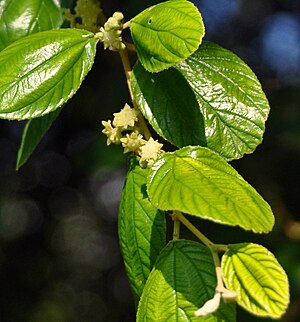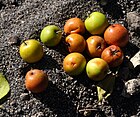Note: This is a project under development. The articles on this wiki are just being initiated and broadly incomplete. You can Help creating new pages.
Difference between revisions of "Ziziphus mauritiana - Common jujube"
(→External Links) |
(→References) |
||
| (17 intermediate revisions by 3 users not shown) | |||
| Line 7: | Line 7: | ||
==Parts Used== | ==Parts Used== | ||
| − | {{Parts Used| | + | {{Parts Used|Seeds}}, {{Parts Used|Roots}}, {{Parts Used|Fruits}}<ref name="Karnataka Medicinal Plants"/>. |
==Chemical Composition== | ==Chemical Composition== | ||
| − | + | Twelve compounds were isolated from the seeds of Ziziphus mauritiana and identified as betulinic aldehyde (1), betulinic acid (2), ceanothic acid (3), frangufoline (4), spinosin (5), beta-sitosterol (6), daucosterol (7), daucosterol-6'-octadecanoate (8), sucrose (9), docosanoic acid (10), stearic acid (11), palmitoleic acid (12).<ref name="Chemical Composition"/> | |
==Common names== | ==Common names== | ||
| − | {{Common names|kn= | + | {{Common names|kn= ಬೋರೇ Bore, ಎಲಚಿ Elachi|ml=Chirimullu, Ilanta|sa=Karkandhu, Kola|ta=Ilandai, Elandai|te=Regi, Regu-pandu|hi=Bara-bor, Kath ber,|en=Indian Jujube|mr=Boor}} |
<ref name="Common names"/> | <ref name="Common names"/> | ||
| Line 37: | Line 37: | ||
==Identification== | ==Identification== | ||
===Leaf=== | ===Leaf=== | ||
| − | {{Leaf|Simple|Alternate| | + | {{Leaf|Simple|Alternate|Distichous; stipular spines solitary or in pairs, straight or one of them recurved; nodes slightly enlarged around the leaf scars.}}<ref name="Leaf"/> |
===Flower=== | ===Flower=== | ||
| − | {{Flower|Axillary cyme| | + | {{Flower|Axillary cyme|Bisexual|Greenish-yellow|5|15-20 flowered dense cymose axillary fascicles, Flowering season is November-March}} |
===Fruit=== | ===Fruit=== | ||
| − | {{Fruit|Drupe|1 x 0.5 cm| | + | {{Fruit|Drupe|1 x 0.5 cm|Oblong-globose, yellow or orange when ripe; 1-2-celled||Seeds 1 or 2, compressed|Fruiting season is November-March}} |
===Other features=== | ===Other features=== | ||
==List of Ayurvedic medicine in which the herb is used== | ==List of Ayurvedic medicine in which the herb is used== | ||
| − | + | [[Ajamamsa rasayana]], [[Panchamla tailam]], [[Dhanvantara taila]], [[Dhanvantari gritha]]<ref name="Karnataka Medicinal Plants"/> | |
==Where to get the saplings== | ==Where to get the saplings== | ||
| Line 55: | Line 55: | ||
==How to plant/cultivate== | ==How to plant/cultivate== | ||
| − | + | Storage of the seed for 4 months to let it after-ripen improves germination. If facilities are available, stratification in sand for 60 - 90 days at 5°c is recommended. Scarification, extracting the seed from the stone, and treating it with sulphuric acid has also been recommended. To germinate, seeds need full sunlight. Seed should germinate in 3 - 4 weeks when the seed is left in stone, quicker if it is cracked, and only 1 week if it is carefully extracted. <ref name="Cultivation details"/> | |
| − | |||
| − | |||
| − | |||
| − | |||
| − | |||
| − | |||
==Commonly seen growing in areas== | ==Commonly seen growing in areas== | ||
| Line 76: | Line 70: | ||
==References== | ==References== | ||
| − | |||
<references> | <references> | ||
| − | <ref name="Uses">[https://easyayurveda.com/2015/07/26/ber-fruit-indian-jujube-uses-dose-side-effect-research/ | + | <ref name="Uses">[https://easyayurveda.com/2015/07/26/ber-fruit-indian-jujube-uses-dose-side-effect-research/ Uses]</ref> |
| − | + | <ref name="Leaf">Kappatagudda - A Repertoire of Medicianal Plants of Gadag by Yashpal Kshirasagar and Sonal Vrishni, Page No. 398</ref> | |
| − | <ref name="Leaf"> | + | <ref name="Cultivation details">[http://tropical.theferns.info/viewtropical.php?id=Ziziphus+mauritiana Cultivation details]</ref> |
| − | + | <ref name="Common names">[http://envis.frlht.org/bot_search Vernacular names]</ref> | |
| − | <ref name="Common names">[http://envis.frlht.org/bot_search | + | <ref name="Chemical Composition">Referred by Library of National Medicine article.</ref> |
| + | <ref name="Karnataka Medicinal Plants">”Karnataka Medicinal Plants Volume - 2” by Dr.M. R. Gurudeva, Page No.112, Published by Divyachandra Prakashana, #45, Paapannana Tota, 1st Main road, Basaveshwara Nagara, Bengaluru. </ref> | ||
</references> | </references> | ||
==External Links== | ==External Links== | ||
| − | * [https://www.epainassist.com/articles/health-benefits-of-jujube-fruit-or-ber-or-ziziphus-mauritiana] | + | * [https://www.epainassist.com/articles/health-benefits-of-jujube-fruit-or-ber-or-ziziphus-mauritiana Ziziphus mauritiana on epain assist.com] |
| − | * [https://www.researchgate.net/publication/282001594_A_PLANT_REVIEW_ON_ZIZIPHUS_MAURITIANA] | + | * [https://www.researchgate.net/publication/282001594_A_PLANT_REVIEW_ON_ZIZIPHUS_MAURITIANA Ziziphus mauritiana on researchgate.net] |
| − | * [http://tropical.theferns.info/viewtropical.php?id=Ziziphus+mauritiana] | + | * [http://tropical.theferns.info/viewtropical.php?id=Ziziphus+mauritiana Ziziphus mauritiana on the ferns.info] |
[[Category:Herbs]] | [[Category:Herbs]] | ||
[[Category:Rhamnaceae]] | [[Category:Rhamnaceae]] | ||
[[Category:Ayurvedic herbs that don't have seed photos]] | [[Category:Ayurvedic herbs that don't have seed photos]] | ||
Latest revision as of 12:30, 4 April 2022
Badarah is a much branched thorny tree that grows in the drier parts of India. The fruits are enjoyed by animals and man alike.
Contents
- 1 Uses
- 2 Parts Used
- 3 Chemical Composition
- 4 Common names
- 5 Properties
- 6 Habit
- 7 Identification
- 8 List of Ayurvedic medicine in which the herb is used
- 9 Where to get the saplings
- 10 Mode of Propagation
- 11 How to plant/cultivate
- 12 Commonly seen growing in areas
- 13 Photo Gallery
- 14 References
- 15 External Links
Uses
Relieves constipation, Relieves excessive thirst, Improves digestion strength, Nasal bleeding, Gastric, Blood disorders, Diarrhea [1]
Parts Used
Chemical Composition
Twelve compounds were isolated from the seeds of Ziziphus mauritiana and identified as betulinic aldehyde (1), betulinic acid (2), ceanothic acid (3), frangufoline (4), spinosin (5), beta-sitosterol (6), daucosterol (7), daucosterol-6'-octadecanoate (8), sucrose (9), docosanoic acid (10), stearic acid (11), palmitoleic acid (12).[3]
Common names
| Language | Common name |
|---|---|
| Kannada | ಬೋರೇ Bore, ಎಲಚಿ Elachi |
| Hindi | Bara-bor, Kath ber, |
| Malayalam | Chirimullu, Ilanta |
| Tamil | Ilandai, Elandai |
| Telugu | Regi, Regu-pandu |
| Marathi | Boor |
| Gujarathi | NA |
| Punjabi | NA |
| Kashmiri | NA |
| Sanskrit | Karkandhu, Kola |
| English | Indian Jujube |
Properties
Reference: Dravya - Substance, Rasa - Taste, Guna - Qualities, Veerya - Potency, Vipaka - Post-digesion effect, Karma - Pharmacological activity, Prabhava - Therepeutics.
Dravya
Rasa
Madhura (Sweet), Amla (Sour)
Guna
Guru (Heavy), Snigdha (Oily)
Veerya
Sheeta (Cold)
Vipaka
Karma
Kapha, Pitta, Vata
Prabhava
Habit
Identification
Leaf
| Kind | Shape | Feature |
|---|---|---|
| Simple | Alternate | Distichous; stipular spines solitary or in pairs, straight or one of them recurved; nodes slightly enlarged around the leaf scars. |
Flower
| Type | Size | Color and composition | Stamen | More information |
|---|---|---|---|---|
| Axillary cyme | Bisexual | Greenish-yellow | 5 | 15-20 flowered dense cymose axillary fascicles, Flowering season is November-March |
Fruit
| Type | Size | Mass | Appearance | Seeds | More information |
|---|---|---|---|---|---|
| Drupe | 1 x 0.5 cm | Oblong-globose, yellow or orange when ripe; 1-2-celled | Seeds 1 or 2, compressed | Fruiting season is November-March |
Other features
List of Ayurvedic medicine in which the herb is used
Ajamamsa rasayana, Panchamla tailam, Dhanvantara taila, Dhanvantari gritha[2]
Where to get the saplings
Mode of Propagation
How to plant/cultivate
Storage of the seed for 4 months to let it after-ripen improves germination. If facilities are available, stratification in sand for 60 - 90 days at 5°c is recommended. Scarification, extracting the seed from the stone, and treating it with sulphuric acid has also been recommended. To germinate, seeds need full sunlight. Seed should germinate in 3 - 4 weeks when the seed is left in stone, quicker if it is cracked, and only 1 week if it is carefully extracted. [6]
Commonly seen growing in areas
Tropical area, Dry deciduous forests.
Photo Gallery
References
- ↑ Uses
- ↑ 2.0 2.1 ”Karnataka Medicinal Plants Volume - 2” by Dr.M. R. Gurudeva, Page No.112, Published by Divyachandra Prakashana, #45, Paapannana Tota, 1st Main road, Basaveshwara Nagara, Bengaluru.
- ↑ Referred by Library of National Medicine article.
- ↑ Vernacular names
- ↑ Kappatagudda - A Repertoire of Medicianal Plants of Gadag by Yashpal Kshirasagar and Sonal Vrishni, Page No. 398
- ↑ Cultivation details
External Links
- Ayurvedic Herbs known to be helpful to treat Relieves constipation
- Ayurvedic Herbs known to be helpful to treat Relieves excessive thirst
- Ayurvedic Herbs known to be helpful to treat Improves digestion strength
- Ayurvedic Herbs known to be helpful to treat Nasal bleeding
- Ayurvedic Herbs known to be helpful to treat Gastric
- Ayurvedic Herbs known to be helpful to treat Blood disorders
- Ayurvedic Herbs known to be helpful to treat Diarrhea
- Herbs with Seeds used in medicine
- Herbs with Roots used in medicine
- Herbs with Fruits used in medicine
- Herbs with common name in Kannada
- Herbs with common name in Hindi
- Herbs with common name in Malayalam
- Herbs with common name in Tamil
- Herbs with common name in Telugu
- Herbs with common name in Marathi
- Herbs with common name in Sanskrit
- Herbs with common name in English
- Habit - Tree
- Index of Plants which can be propagated by Seeds
- Herbs that are commonly seen in the region of Tropical area
- Herbs that are commonly seen in the region of Dry deciduous forests
- Herbs
- Rhamnaceae
- Ayurvedic herbs that don't have seed photos





